- Home
- Diane Ackerman
A Natural History of Love Page 3
A Natural History of Love Read online
Page 3
In paintings, men are shown bare chested, straight and strong, with wide shoulders tapering to a narrow waist—the shape of the hunter in the constellation Orion. Women are tall and bosomy, and often glamorously dressed, with stylized eye makeup, and long black hair carefully plaited and perfumed with unguents. Egyptian women did not take part in government (except for the occasional female pharaoh), but they traveled freely, enjoyed many of the same pastimes and activities that men did, and commanded more respect than women in other lands.
The hieroglyphic word for love (as a noun or a verb) consists of a hoe, a mouth, and a man with a hand in his mouth. No doubt Egyptians spoke of love without dwelling too long on the etymology of the word, just as we refer to our muscles without thinking about mice running under our skin.* The sign literally meant “to want, choose, or desire,” but it could also include the idea of duration, to want over a period of time, or, as we say, to love. Most Egyptologists don’t regard the mouth and hoe symbolically, but rather as sounds, just as we would the letters l and v. I would like to think the letters sounded like the wind blowing through the sand, and that you had to purse your lips into a waiting kiss just to utter them. But we have no idea what ancient Egyptian sounded like, any more than we do the Greek of that era. The man with a hand to his mouth is a sign that frequently occurs at the end of words having to do with eating, drinking, speaking, thinking—anything that involves functions of the mouth or of the heart. (Feelings were thought to reside in the brain.)
It is interesting to look at what their word for love implies. To a Freudian, it might be a sexual euphemism, with the long, stiff hoe representing a penis, the mouth a vagina, and the man with a hand in his mouth lovemaking. Interpreted this way, the word would emphasize how fixated we are on the oral. Or perhaps the word is entirely agricultural—lovers till the earth of a relationship, raising the food of love, with which they nourish each other. Perhaps it is economic. Marriage is chiefly an economic institution, joining clans, forging alliances between families, uniting properties. There is no woman in this picture, unless she is symbolized by her mouth, a disembodied kiss. So perhaps it depicts love from a man’s point of view, filling his days with labor and his nights with kisses.
The garden was a favorite setting for romance in Egypt, and poems often draw on such sights and smells. In ancient times, in desert worlds, few things were more soul-drenching than the idea of an oasis. A hidden garden in the aridity of life soon became a metaphor for love. In the biblical Song of Solomon—which was preceded by similar songs in ancient Egypt and Sumeria—King Solomon sings to his intended that her virginity is like a luscious garden he will soon enter. Then he mentions one by one all the fruits he will pick, all the scents he will inhale. We tend to forget that King Solomon’s frequent marriages were part of a pagan fertility ritual. He had 700 wives and 300 concubines. If he courted even a few with the same degree of devotion and poetry, then one can only lament the volumes of his writings that have been lost. And where are Cleopatra’s love poems? Given her youth and disposition, and her long separations from Antony, she must have committed her heart to paper.
THE HIEROGLYPHIC LOVE POEMS
Egyptologists have found fifty-five anonymous love poems, on papyri* and vases, dating back to around 1300 B.C. Certainly there were poems written earlier; but papyri and vases are extremely perishable. Although we don’t know the authors of the poems, they were most likely written by both men and women. Some of them are alternating duets between lovers. Told first from one point of view, then the next, they show psyches torn by uncertainty, hearts on fire. Here is part of a typical hieroglyphic love poem, “Conversations in Courtship,” in which a man describes his darling as
More lovely than all other womanhood, luminous, perfect,
A star coming over the sky-line at new year, a good year,
Splendid in colours, with allure in the eye’s turn.
Her lips are enchantment, her neck the right length and her breasts a marvel;
Her hair lapis lazuli in its glitter, her arms more splendid than gold.
Her fingers make me see petals, the lotus’ are like that.
Her flanks are modeled as should be, her legs beyond all other beauty.
Noble her walking (vera incessu)
My heart would be a slave should she enfold me.
In another poem, “Pleasant Songs of the Sweetheart Who Meets You in the Fields,” we find a woman hunting birds:
My darling—my beloved—whose love empowers me,
Listen to what I tell you:
I went to the field where birds gather.
I held in one hand a trap, and in the other a net and spear.
I saw many birds flying from the land of Punt
Laden with sweet fragrance to alight on Egypt’s soil.
The first snatched the bait from my hand.
He had a beautiful odor and his claws held incense.
But, for your sake, dear beloved, I will set him free,
Because I would like you, when far away,
To listen to the song of the bird
Scented with myrrh.
How wonderful to go to the fields when one’s heart is consumed by love!
The goose cries out, the goose that snatched the bait and was trapped.
Your love distracted me and I could not keep it.
I will fold the nets, but what can I tell mother
When I return each day without birds?
I will say I failed to set my nets,
Because the nets of your love have trapped me.
Although these poems were written over three thousand years ago, they weave together many of the same themes, worries, and rejoicings we find in love poems today. They tell us what mattered to Egyptian lovers (and still vexes us). A few of their key themes:
1. Love’s alchemy, or the power to transform. Sad as it seems, human beings have always been unhappy with who they are. Even the most comely of us feel like eternally ugly ducklings who yearn to be transformed into swans. One of the bad jokes of evolution is that we have evolved brains which can imagine a state of perfection we cannot achieve. When Plato wrote that everything on earth has its ideal version in heaven, many took what he said literally. But for me the importance of Plato’s ideal forms lies not in their truth but in our desire for the flawless. No one can live up to perfection, and most of us do not often expect it of others; but we are more demanding with ourselves. Egyptian lovers, feeling transformed by love, based their belief on a subconscious faith in magic. In a world menacing and implausible, only faith could explain it, only magic control it.
Another feature of love’s alchemy is the idea of improvement. Why are we so obsessed with improving everything around us: our lawn, our aluminum siding, our chances, ourselves? Regardless of talent, looks, or good fortune, we feel ourselves to be inadequate and in need of some extra genius or flair or energy or serenity. Perhaps this is because so much of our experience of life happens as thought, interior monologue, and dream. Language helps to define our feelings, but many of our moods and tempers cannot be articulated. And memory provides us with a circus of shortcomings. It doesn’t matter that those events happened when we were younger, in dire straits, frightened, or less wise. We sense that we are impostors. Keeping our failings a secret, we assume no one on earth is as neurotic, no one as uniquely flawed. The rampantly beautiful person we are attracted to couldn’t possibly be as frail. He is a contagion of virtues. Loving him, we sing his praises, highlighting all his good points. We redefine him to himself. Through love one learns to feel lovable.
2. Idealizing the beloved in images drawn from nature. Why should it flatter a person to be compared to stars, gemstones, flowers, or perfumes? Why not compare one another to skyscrapers, Persian rugs, filigree ironwork, covered bridges, or steaming macadam? Sometimes we do, especially in modern poetry, but lovers mainly rhapsodize about each other’s body and its parts in terms of sun and moon, plants and hillocks. The lover rationalizes his carna
l worship by saying to himself, in effect, “Her brown eyes are as absolute as nightfall, her mouth as dew-struck as morning.” Or as the author of the Egyptian courtship poem puts it: her black hair glitters like lapis lazuli, and her arms are the pure gold of an idol. Love speaks in absolutes, but the only absolutes we know are the workings of nature or the mastery of gods.
3. Love as enslavement. Sometimes I think all of life can be seen as a struggle to keep one’s own freedom or to steal someone else’s. We are so alike you would think one voice could speak for all of us. But let a dictator arise—of a country or of a family—and rebellion eventually ensues. Freedom is an idea worth killing for. Throughout our lives, we feel trapped by family, society, age, gender, job. Also by many intangibles: tradition, religious teachings, and our own and others’ expectations of ourselves. How we shudder at the thought of being enslaved to an illness or an injury. Being an automaton isn’t human, and we prize the curious hallmarks of our humanity. To take orders is to be low man on the totem pole, and we upright apes are forever clambering toward the top.
Yet in love we become willing prisoners. If you remove the idea of the beloved and replace it with the tyrant, but keep the same degree of obsession, servility, sacrifice, uncertainty, and loss of freedom, what do you have? A police state. In the banana republic of the heart, petty tyrants can drag one away by nightfall for some gentle terror. Love makes mania respectable. Not only does it enslave, it issues proclamations and directives. Love speaks, gives its own orders.* In poems, lovers frequently report: “Love bid me go, and I followed.” Love is often depicted as a state of mnemonic possession, in which the spirit of love speaks through someone, urging them to act in uninhibited ways. We allow only our rulers and gods to possess us body and soul, as if we were nothing more than ventriloquists’ dummies, to dictate our actions and determine our fate. We build love temples and shrines, where we enter as supplicants, practice love as a form of religion, complete with personal savior, acolytes, and rituals. How can we explain the recklessness, the sheer abandon of love, if we don’t see it as the work of a despot or a force of nature, a divine tornado that has swept us up?
4. Being disabled. So it follows, paradoxically, that love is both a fortifying and a disabling emotion. Lovers moon about, sigh, fantasize about each other. They can’t keep their minds on their work, they abandon their normal pursuits. The beloved becomes a mantra that focuses the lover’s thoughts in a cleansing way. All else is distraction. The lover lives in a waking faint. We describe such lovers with words of drunkenness or witchery. Their condition is so familiar to us we don’t find it particularly odd that, every now and then, people go haywire, lose their ability to think clearly, have stomachaches, can’t sleep properly, and spend hours daydreaming. Such a state has all the earmarks of disease and, as the Egyptian love poems remind us, people have always described love as a sickness.
5. A secret kept from one’s parents. No one wants to tell his parents that he has fallen in love. Why be furtive about it? One’s parents have flirted, fallen in love, felt sexy. Yet lovers feel embarrassed by the extravagance of their obsession, try to disguise their feelings, and worry that their kin will know. There is a sense of wickedness or shame attached to it. I suspect that this is because it feels like a betrayal, an act of treason, that will carry them away from the family. Love for parents will be superseded by love for spouse and children. They will sneak away into another tribe and pledge devotion to outsiders.
6. Redoubling of the senses. “Her fingers make me see petals,” the hieroglyph poet writes. Love produces synesthesia. All the usual categories blur and one experiences the world freshly, as a waterfall of sensations. We often indulge in platitudes about how love makes us “young again,” or “brings out the child in us.” But you can look at it from the opposite perspective, too. Watching young animals at play, one sees them unwittingly practicing all the essential behaviors of courtship. Love returns us to a time when there were fewer people to worry about, when we were powerfully dependent on parents who gave us everything—food, warmth, attention, affection, tenderness.
MY SISTER, MY BRIDE
One custom of the ancient Egyptians that shocks most of us is incest. Lovers in the poems frequently address one another tenderly as brother or sister. Yet to us, and to peoples throughout the world, throughout the ages, incest is a taboo, a practice horrible to imagine, unnatural and damning. Parent-child incest is regarded as the most heinous, because it thrives on exploitation, power, and domination. The older family member is seen to be preying on the younger, who is innocent and helpless. In Greek tragedy, Oedipus was doomed to blindness and wandering because he had slept with his mother, though unknowingly. There is something particularly offensive about the idea that he reinserted part of himself into the place from which he was born. Centuries later, Freud would be jeered in psychiatric circles for suggesting that male children felt Oedipal desires—jealousy toward Father, a yearning for union with Mother. His colleagues were not simply disbelieving of his theory; they were appalled.
Another reason for the powerful incest taboos, which exist among other animals as well, is that incest is the ultimate form of inbreeding. If individuals marry only within a small family group, the same genes will be passed to all the offspring. But the environment changes, new diseases evolve, the harvest sometimes fails, herds vanish, new predators arrive. In an unstable world, only the ingenious survive. Evolution works by mixing bloodlines, so that there will always be someone around who can adapt to change. Variety is not just the spice of life, it’s evolution’s crucial ingredient. We need genetic variety to deal with the changing landscape and the caravan of frights we encounter in a lifetime. Inbreeding for only twenty generations will produce homogeneity.
An example of what happens if incest goes unchecked can be seen in the animal world today—the predicament of the cheetah. Because cheetahs are highly endangered, and there are precious few of them in the wild, they have inbred for some time. A microscopic look at their DNA is disturbing. They are essentially clones of one another. They all look the same, all heal the same; no new traits or strengths are being passed along to the young. A virus that can kill one cheetah can kill every cheetah. Throughout the animal kingdom, hybrids are stronger, produce larger litters, and live longer. There’s no doubt that the incest taboo has a biological basis, but there are also many sociological, psychoanalytical, and anthropological theories. The strongest argument is a combination of genetic and social.
One thing we know for sure is that in our distant past there were fewer people. A million years ago, the entire worldwide human population was about 500,000, smaller than the cities of Oslo or Nairobi. Incest was essential then for the species to survive. Infant mortality was high. But as tribes grew in number, so did the possibilities for genetic mixing. And for romance. Desirable women were swapped to form political alliances. As Reay Tannahill reminds us in Sex in History, “ ‘love at first sight’ is possible only between strangers.” The Bible often refers to (and condones) incestuous marriages; in the days of the Old Testament, relatives were encouraged to marry. By the time of the Egyptians, marrying out of the family was normal, but it was also common for brother and sister to marry if it seemed convenient. This doesn’t mean that they consummated the union, or were faithful to each other, bearing each other’s children. Among the Egyptians, incest was a practical way to keep real estate in the family, since women could inherit property. It was a custom based on economics, not familiarity. Even so, one hears of brother and sister marrying, not parent and child. A family is like a city-state in which everyone has an important role to play, depending on their relationship with one another. Here is the tangle of role reversals that would be produced by a father-daughter marriage:
A resulting son would be a half-brother of his mother, his grand-mother’s stepson, his mother’s brother’s half-brother, and not only his father’s child but his grandson as well! Note the problems of identity and exercise of authority: should h
e act toward his mother as a son or as a half-brother; should the uncle be treated as an uncle or as a half-brother? … if a brother and sister were to marry and then divorce, could they readily revert to their original relationship?
Not only would the integrity of the family be impossible to maintain, daily life would be plain confusing. In any case, marriage was useful for forging kinship bonds and establishing individuals’ roles in society. Incest kept love on a tight leash, but the family in control.
A LONG DESIRE
At first glance, the ancient Egyptians seem exotic, glaringly different from us, and in some ways they were. But not when it comes to loving. Our attitudes about love are as old as the pyramids. The Egyptians were sentimental and romantic about love. Their word for love meant something like “a long desire.” Relying on a rich array of metaphors, their love poems are, even if sometimes sappy, free of guilt, self-abasement, or that curious combination of love/hate we see so often today. We don’t have Egyptian writings about homosexual love per se, but The Egyptian Book of the Dead includes a passage in which the deceased swears that he hasn’t had sex with a boy. Homosexuality must have been commonplace, the seduction of boys a frequent temptation, or it wouldn’t have been forbidden. We do find fetishism, masochism, and other fringe elements, plus a practical concern with contraception, for which women used a pessary of elephant and crocodile dung. Love is sometimes thought of as a sweet trap, sometimes as a sickness one craves. But no god or goddess steers the course of lovers, foiling their efforts, tempting their faith. Though they feel swept away by love’s power, they blame no one. Poetry records the heartbeat of a people, and thanks to the Egyptian poets we know that love thrived in ancient days, a familiar, modern sort of love, which had little to do with the hard currency of marriage. They felt the same sweet calamities that lovers do today.

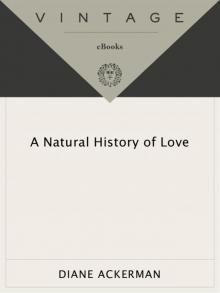 A Natural History of Love
A Natural History of Love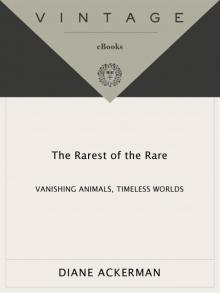 The Rarest of the Rare: Vanishing Animals, Timeless Worlds
The Rarest of the Rare: Vanishing Animals, Timeless Worlds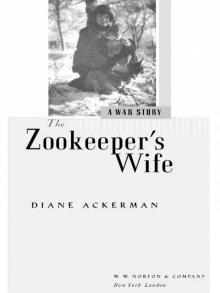 The Zookeeper's Wife: A War Story
The Zookeeper's Wife: A War Story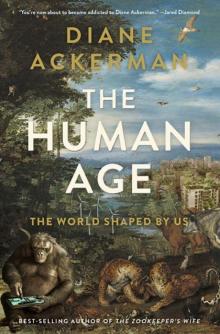 The Human Age: The World Shaped by Us
The Human Age: The World Shaped by Us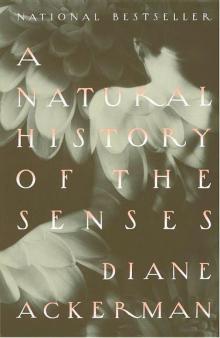 A Natural History of the Senses
A Natural History of the Senses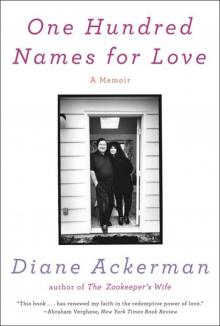 One Hundred Names for Love: A Memoir
One Hundred Names for Love: A Memoir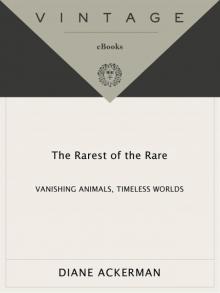 The Rarest of the Rare
The Rarest of the Rare